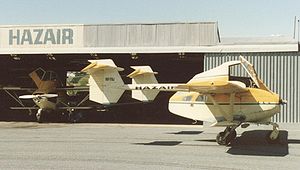
Transavia Corporation
Encyclopedia
Transavia Corporation was an Australia
n aircraft manufacturer active between 1965 and 1985.
The initial design of the Airtruck had been created in New Zealand
by Luigi Pellarini in 1956 as the single Kingsford Smith PL-7 tanker aircraft. This used parts from T-6 Texan
aircraft and a Cheetah
engine. Two further more refined PL-11 Airtruck
aircraft were built in New Zealand during the early 1960s by Bennett Aviation, later Waitomo Aircraft Ltd.
The design was taken over by Transavia Corporation in 1965 and the company refined the aircraft's specification as the Transavia PL-12 Airtruk
.
 The PL-12 had an unconventional but practical layout for its intended agricultural top-dressing role. The basic layout was inherited from the PL-11. This was a mid-wing monoplane
The PL-12 had an unconventional but practical layout for its intended agricultural top-dressing role. The basic layout was inherited from the PL-11. This was a mid-wing monoplane
, but with a small lower "wing" that carried the wing bracing struts and the two main wheels of the tricycle undercarriage. Slender booms carried the two separate tailplanes on top of the fin/rudder units. The two booms were not joined together at the aircraft's rear.
The cockpit was located on top of a stubby fuselage, giving good visibility for low-level flying and the chemical hopper was situated below the pilot with a loading aperture just behind the cockpit. A cargo carrying utility version was also built. Power for early production was from a Continental IO-520-D 300 h.p. engine.
Further refinements in design in 1981 brought the PL-12-300 "Skyfarmer" with strengthened upper fuselage and a larger cockpit with roll-over truss. The final derivative was the PL-12-400 with a Lycoming
I0-720 400 h.p. engine, larger dorsal fin and lower sesquiplane "wings". Total Airtruk production by Transavia was 118 aircraft. Examples are still in active operation.
Australia
Australia , officially the Commonwealth of Australia, is a country in the Southern Hemisphere comprising the mainland of the Australian continent, the island of Tasmania, and numerous smaller islands in the Indian and Pacific Oceans. It is the world's sixth-largest country by total area...
n aircraft manufacturer active between 1965 and 1985.
Formation
Transavia Corporation Pty Ltd was formed in 1965, as a subsidiary of Transfield NSW Pty to produce agricultural aircraft.The initial design of the Airtruck had been created in New Zealand
New Zealand
New Zealand is an island country in the south-western Pacific Ocean comprising two main landmasses and numerous smaller islands. The country is situated some east of Australia across the Tasman Sea, and roughly south of the Pacific island nations of New Caledonia, Fiji, and Tonga...
by Luigi Pellarini in 1956 as the single Kingsford Smith PL-7 tanker aircraft. This used parts from T-6 Texan
T-6 Texan
The North American Aviation T-6 Texan was a single-engine advanced trainer aircraft used to train pilots of the United States Army Air Forces, United States Navy, Royal Air Force and other air forces of the British Commonwealth during World War II and into the 1950s...
aircraft and a Cheetah
Cheetah
The cheetah is a large-sized feline inhabiting most of Africa and parts of the Middle East. The cheetah is the only extant member of the genus Acinonyx, most notable for modifications in the species' paws...
engine. Two further more refined PL-11 Airtruck
Bennett Airtruck
The PL-11 Airtruck is a New Zealand agricultural aircraft.A strikingly unusual aircraft, the PL-11 Airtruck was designed as a de Havilland Tiger Moth replacement for the New Zealand aerial topdressing market by Luigi Pellarini in 1960 for Waitomo Aircraft. The prototype was constructed using bits...
aircraft were built in New Zealand during the early 1960s by Bennett Aviation, later Waitomo Aircraft Ltd.
The design was taken over by Transavia Corporation in 1965 and the company refined the aircraft's specification as the Transavia PL-12 Airtruk
Transavia PL-12 Airtruk
-Bibliography:*Donald, David . The Encyclopedia of World Aircraft. Leicester, UK: Blitz, 1997. ISBN 1-85605-375-X.*Taylor, John W R. . Jane's All the Worlds Aircraft 1976-77. London:Jane's Yearbooks, 1976. ISBN 0 354 00538 3....
.
Aircraft designs

Monoplane
A monoplane is a fixed-wing aircraft with one main set of wing surfaces, in contrast to a biplane or triplane. Since the late 1930s it has been the most common form for a fixed wing aircraft.-Types of monoplane:...
, but with a small lower "wing" that carried the wing bracing struts and the two main wheels of the tricycle undercarriage. Slender booms carried the two separate tailplanes on top of the fin/rudder units. The two booms were not joined together at the aircraft's rear.
The cockpit was located on top of a stubby fuselage, giving good visibility for low-level flying and the chemical hopper was situated below the pilot with a loading aperture just behind the cockpit. A cargo carrying utility version was also built. Power for early production was from a Continental IO-520-D 300 h.p. engine.
Further refinements in design in 1981 brought the PL-12-300 "Skyfarmer" with strengthened upper fuselage and a larger cockpit with roll-over truss. The final derivative was the PL-12-400 with a Lycoming
Lycoming Engines
Lycoming Engines is a U.S. aircraft engine company, known primarily for its general aviation engines. For most of its history Lycoming has been part of the AVCO group as AVCO Lycoming. In 1987 AVCO was purchased by Textron to become Textron Lycoming...
I0-720 400 h.p. engine, larger dorsal fin and lower sesquiplane "wings". Total Airtruk production by Transavia was 118 aircraft. Examples are still in active operation.

